Why Read This Article?
Finish Nailer Repair - Replacing the Driver Guide (Ridgid Part # 79004001022)
Article Breakdown
Finish Nailer Repair - Replacing the Driver Guide (Ridgid Part # 79004001022)
1. The overall measurements of the blade.
2. The shape, number, situation, and measurements of the blades holes.
Every lawn mower blade has at least one hole in it for where it attaches to the machine.
"Overall measurements" include the blade's length, width, and thickness.
Regarding the blade's holes, the number of holes, the shape of the holes, the size of each hole, and the distance between the outer holes must be known.
After-market mower blades are listed by these measurements. So, even though a given mower model will correspond to only one specific blade design (its measurements and holes), information about the holes and other measurements must be used to find the right blades.
Below we describe each of these measurements in detail and explain how to take them.
Blade Length
Mower blade length gets measures like television screens are measured: corner to corner.
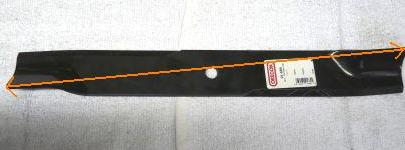 This is an easy measurement to take, and will most likely be one of the first that users see in a replacement blade's description. Mower blades come in a span of lengths from as small as almost 6" to over 32".
This is an easy measurement to take, and will most likely be one of the first that users see in a replacement blade's description. Mower blades come in a span of lengths from as small as almost 6" to over 32".
[Back to top]
Blade Width and Thickness
These measurements are as straight forward as they sound, and are also used to identify compatible replacement mower blades.
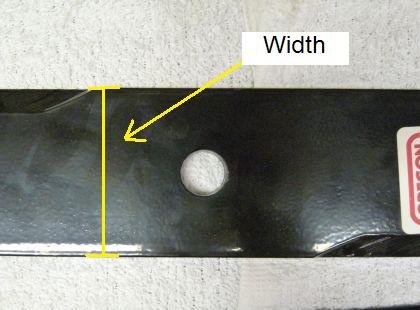
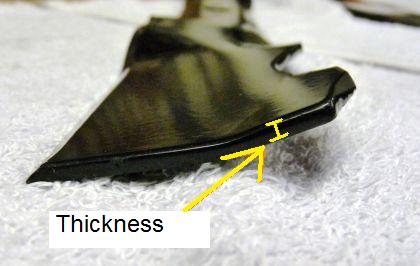 Mower blades can be 1 1/2" to 4 1/4" in width, and are available in thicknesses ranging from about 1/10" to almost 1/3".
[Back to top]
Number of Holes
Lawn mower blades will have either one or three holes in them for where they attach to the machine.
Mower blades can be 1 1/2" to 4 1/4" in width, and are available in thicknesses ranging from about 1/10" to almost 1/3".
[Back to top]
Number of Holes
Lawn mower blades will have either one or three holes in them for where they attach to the machine.
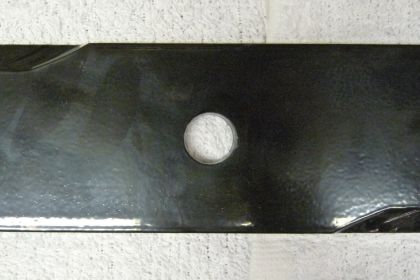
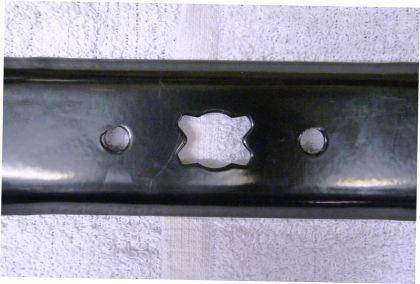 Obviously, this information is also important for matching mower blades.
[Back to top]
Hole Shapes
In addition to other blade differences, manufacturers cut the holes in mower blades to several different shapes. The most common shapes for mower blade holes are circular, rectangular, star, and 7-star.
Holes that go simply as "star" shaped are stars with five points and are also called "5/8 star." "7-star" holes have seven points on them and also go by "7/8 star."
[Back to top]
Hole Measurements
Measurements for square holes and round holes are also needed. These measurements are taken in inches, and measure the diameter of the holes.
A separate measurement is taken for both the center hole and the outer holes. These numbers will be listed separately in a blade's description as the "center hole size" and the "outer hole size."
Obviously, this information is also important for matching mower blades.
[Back to top]
Hole Shapes
In addition to other blade differences, manufacturers cut the holes in mower blades to several different shapes. The most common shapes for mower blade holes are circular, rectangular, star, and 7-star.
Holes that go simply as "star" shaped are stars with five points and are also called "5/8 star." "7-star" holes have seven points on them and also go by "7/8 star."
[Back to top]
Hole Measurements
Measurements for square holes and round holes are also needed. These measurements are taken in inches, and measure the diameter of the holes.
A separate measurement is taken for both the center hole and the outer holes. These numbers will be listed separately in a blade's description as the "center hole size" and the "outer hole size."
[Back to top]
The Center-to-Center Measurement
The last measurement needed to match compatible blades to mowers is the "center to center" measurement. This measurement is the distance between the centers of the mower blade's outer holes (if it has outer holes).
Obviously, one hole mower blades won't have this measurement.
All of these blade measurements work together to provide a very detailed description of the mower blade, and ensure that the right configuration of holes, hole sizes, and hole distance is found to match a mower's design.
[Back to top]
Matching Mower Blade Search Steps
The following are steps that should be taken before beginning a search for a matching mower blade.
1. Take the overall measurements of the blade: length, width, and thickness.
2. Get all of the hole information and measurements: number of holes, size of the holes (center and outer), and the center-to-center measurement.
Now for the good news: the rest is easy. If you have those three numbers, matching the right replacement mower blade only takes a moment.
Below are steps for using these measurements with eReplacementParts.com's easy search filter features on our "Lawn Mower Blades" page. All you have to do is click the correct measurements on the page, and it will automatically filter the search results to only display blades that match those measurements.
1. Navigate to the Lawn Mower Blades page on eReplacementParts.com.
Below is a link to our Lawn Mower Blades page:
https://www.ereplacementparts.com/lawn-mower-blades-c-714_17587_22529.html
This page will display all of the hundreds of mower blades that we currently carry, before the search results are narrowed that is.
2. Narrow Search Results by the Blade's Overall Measurements.
There is a box titled "Narrow Listings By:" at the top of the "Lawn Mower Blades" page. Below the title of the box are click-able buttons in brackets for narrowing the displayed search results. Here's what it looks like:
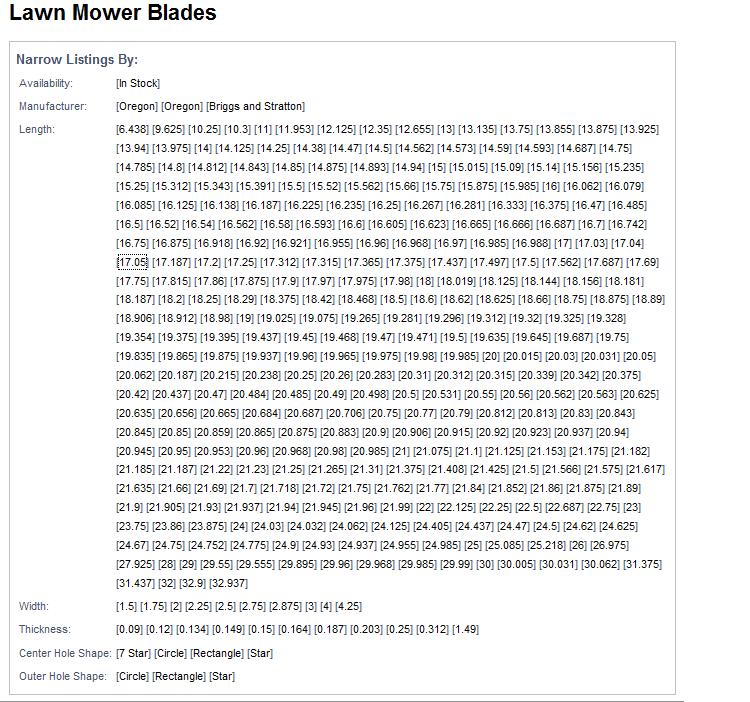
To narrow the search results to list only blades whose measurements match the blade you're looking for, simply click the correct measurement in the "Narrow Listings By:" box. When you do, the page will automatically refresh and display only the blades that match the selected measurement
So, for example, if I were to click the "[20"]" button next to where it says "Length:", the page will only display blades with a 20" length when the page automatically refreshes.
Also, after narrowing down the results by clicking a measurement, the click-able buttons for that measurement category will disappear when the page refreshes, since that blade quality has already been determined. So, after clicking the "[20"]" length measurement button, all of the "Length:" measurement buttons will disappear when the page refreshes.
3. Continue to Narrow Search Results with Other Measurements
In the "Narrow Listings By:" box, continue to match measurements and hole information about the desired mower blade by clicking the correct buttons for those measurement categories, as described in Step 2.
This will further narrow the search results to only blades that match all of the selected measurements and hole shapes.
Just as described above, the page will automatically refresh after making each new selection, displaying narrower search results and removing the already-determined measurement buttons.
The search can also be narrowed further by manufacturer and availability if desired.
Once overall measurements, hole measurements, and hole shapes are selected, the search results still might display many different matching blades. This is because there are still a number of blade type and feature variations, even withing blades of the same measurements and hole orientation.
And that's it for selecting a compatible lawn mower blade! [Back to top] Major Lawn Mower Blade Types Although a mower is restricted to using blades that correspond to a matching configuration of holes and measurements, most mowers will still have several blade type options available that are compatible. Lawn mower blade types employ different designs that offer a variety of "lift" and mulching options. The major types of lawn mower blades are described below:
Low Lift Blades-
Low lift blades are primarily for side discharge mowing. Their design includes a less-drastic swoop than high lift blades, encouraging the cut grass to stay low where it is more available to be ejected out the side of the mower.
High Lift Blades-
With a more vertical swoop shape, high lift air underneath the mower better than low lift blades. This fan-like suction makes high lift blades ideal for bagging purposes, making bagging more efficient, and reducing the chance for the cut grass to get clogged up in the mower's cutting area.
Mulching Blades-
The best blades for mulching are low lift blades that include an additional feature, a short dip in the blade's profile. Together, the low lift and the extra dip helps toss the grass around under the mower so that it can be mulched a bit before ejection. Accordingly, these are called mulching blades.
3-in-1/"Gator" Blades-
For users that want an all around solution, these blades cover all the bases. Commonly referred to as "gator" blades, these combine a medium lift (low and high) with a mulching feature to combine the three grass cutting approaches into one, also giving them the occasional name of "3-in-1" blades.
Gator blades are easy to spot because of their serrated segments at either end of the blade. Although they make higher lift mulching possible by using more than one design focus, 3-in-1 blades fall a little short in each area, high lift, low lift, and mulching, in order to reach that compromise. They remain very popular and are great for all around grass cutting use. [Back to top] Conclusion Like Hammer Drill Bits, Chainsaw Chains, and other tool accessories, some measurements and other information are needed when ordering replacement lawn mower blades. Because every mower will go through at least more than one blade in its lifetime, we've made finding exactly the right blade on our website easy. Visit our lawn mower parts page to find the mower blade you're looking for with just a few clicks. [Back to top] What we're about.

When it's time to replace a chain, it is especially important to have all the right information regarding the chainsaw and its chain size. Matching the right chain to a chainsaw is easy if you have the right measurements, however, matching the right chain to a chainsaw is a little more complicated than finding other power tool accessories, because of the unique way that chainsaw chains are measured.
The information below explains exactly how chainsaw chains are measured, the difference between these measurements, and how to quickly find the measurement numbers needed to order the correct chain.
After matching the right size of chain there is still a host of chainsaw chain types and features to choose from and match to the application, but that's usually much more straight-forward than finding measurements.
Finally, this article also provides step-by-step search instructions for finding the correct chainsaw chain on eReplacementParts.com. Our search filtering features make finding the right chain extremely easy when customers have the necessary measurement numbers.
But first, let's talk about the three measurements that are absolutely necessary for matching chainsaw chains.
The 3 Necessary Chainsaw Chain Numbers
There are three measurements that every chainsaw user must know ahead of time to match the right size chainsaw chain to their chainsaw:
1. Pitch
2. Gauge, and
3. the numberof drive links (yes, they must be counted) The following is a complete explanation of how these qualities are measured on chainsaw chains, what the most common measurements are, how to find these measurements, and how to measure them when they cannot be found. 1. Pitch Measurement The pitch of a chainsaw chain is a measurement that describes how close together links are on the chain. It does not tell you how many links are present, or what the overall length of the chain is.
Pitch = the distance between any 3 rivets on the chain, divided by half. (see picture below)

Yes, that's kind of a complicated measurement, but luckily, most chainsaws display this measurement somewhere on the tool or in the user manual. Chainsaw chains are available in the following pitch sizes, measured in inches:
1/4", .325", 3/8", 3/8" low-profile, and .404". 3/8" pitch chains are the most common pitch size, and 3/8" low-profile pitch chains are even more common than regular 3/8" chains. 3/8" low-profile chains displace a smaller amount of the material being cut, because their "kerf" (the width of material removed in cutting) is more narrow, reducing the power needed for cutting. 3/8" low-profile chains typically fit chainsaws whose guide bars are 18" or shorter in length, which are the majority of medium-use, non-professional application chainsaws such as a homeowner might own. .404" pitch chains are normally for larger, professional-grade chainsaws often used by the likes of firemen and rescue workers. The greater distance between links makes for more aggressive cutting. When a chainsaw chain's pitch measurement is displayed on the tool, it is usually on the guide bar, towards the user-end of the tool. Sometimes the measurement is displayed very clearly, and sometimes it is mixed in with a bunch of other numbers, so you have to know what to look for. When a pitch number can't be found on the tool or in the user manual, pitch can be measured, but because a high level of accuracy is needed to tell the difference between .325" and 3/8", for example, it is often a better idea to take the saw to a shop to be measured. If you decide to measure the pitch yourself, just remember to measure between the middle points of 3 rivets on the chain, and then divide the number by 2. So, for a 3/8" pitch chain, the measurement between three links would be 3/4" (.75"), which is 3/8" (.375") when divided by 2. [Back to top] 2. Gauge Measurement The parts of chainsaw chains that fit into the saw's guide bar are called the drive links. The drive link is the bottom part of the chainsaw chain (see picture below).

Gauge measures the thickness of the drive links if you were to look at them along the length of the chain.

Obviously, it is important to match the right chain gauge to the saw so that the chain will fit into the guide bar correctly. Chainsaw chains are available in the following gauge measurements, also measured in inches:
.043", .050", .058", and .063". .050" is the most common gauge. Like the pitch measurement, the gauge measurement is often displayed on the chainsaw, usually towards the user-end of the guide bar. Also like the pitch measurement, the gauge measurement can either be displayed clearly or jumbled in with a bunch of other numbers, so it's important to have an idea of what kind of numbers to look for. Because gauge measurements are so small, it is not recommended that users measure gauge themselves if the measurement can't be found on the tool or in the user manual. However, if a pair of accurate calipers are available, measuring gauge is a cinch. Without calipers, we recommend taking the saw to a shop to have the chain gauge measured (some toolmen are so familiar with these chains that they will be able to identify its measurements by sight). [Back to top] 3. Number of Drive Links To get the right chainsaw chain, the number of drive links on the chain must be counted if the count is not already known. Overall length measurements of chainsaw chains (such as "a 2 foot chain" etc.) are not helpful for finding the right chainsaw chain. This is because the overall length of chainsaw chains is determined by a combination of pitch (distance between links) and the number of drive links. This is the most accurate way for chain manufacturers to keep all the different sizes and types of chains in order. The number of links on a chain is normally not displayed on the tool like pitch and gauge, or listed in the manual. This is why the links must be counted.

[Back to top]
Chain-Matching Search Steps
The following are steps that should be taken before beginning a search for a matching chainsaw chain.
1. Get the pitch measurement of the chain either by finding it on the tool, in the user manual, or dividing the distance between 3 links by 2 (recommended that this be done by a shop).
2. Get the gauge measurement of the chain either by finding it on the tool, in the user manual, or by measuring the thickness of the chain's drive links with very accurate calipers.
3. Count the number of individual drive links in the chain. No exceptions. Now for the good news: the rest is easy. If you have those three numbers, matching the right replacement chain only takes a moment. Below are steps for using these 3 numbers with eReplacementParts.com's easy search filter features on our "Chainsaw Chains" page. All you have to do is click the correct measurements and number of links on the page, and it will automatically filter the search results to display only the chains that match those measurements.
1. Navigate to the "Chainsaw Chains" Page on eReplacementParts.com.
Below is a link to our Chainsaw Chains page:


















































